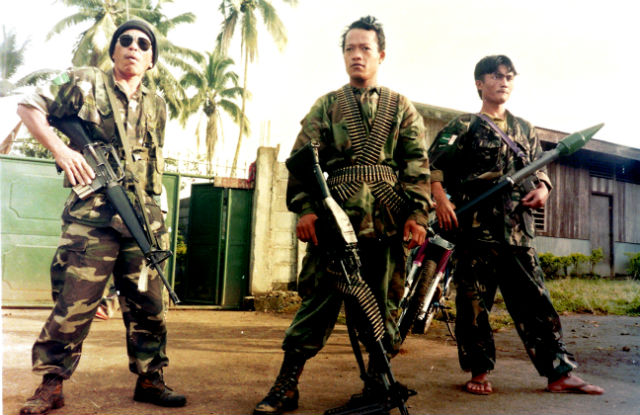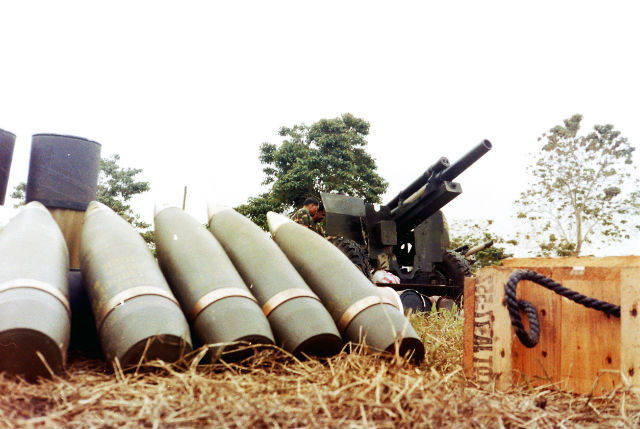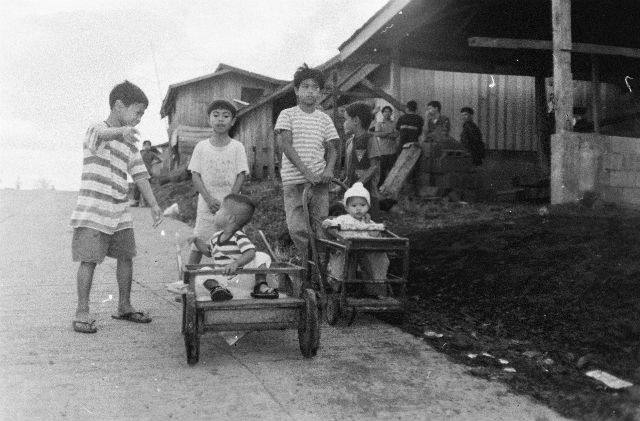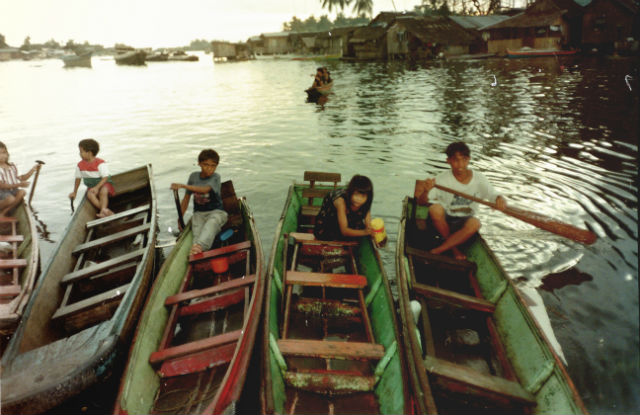TIPO-TIPO, Basilan, August 2007: The province had lapsed into yet another of its seemingly interminable wars after suspected Moro Islamic Liberation Front (MILF) and Abu Sayyaf fighters killed and beheaded Marine troopers who were searching for kidnapped Italian priest Giancarlo Bossi. But Tipo-Tipo Mayor Ingatun Estarul had much more on his mind as government troops geared up for an offensive in nearby Albarka and refugees began streaming into his town. The children, Estarul said, are missing school again. “If we do not head this off,” Estarul said, “the real effect will be felt 10 to 15 years from now.” It was remarkable foresight from an official whose constituents are forced to survive only from day to day. “If the children are allowed not to get an education, they are prone to be criminals in the future,” he remarked during our brief encounter. “Our observation way back from 1972 up to the late 1980s is that the active lawless elements of today are the product of those babies born at that time.” Children born in conflict are in danger of becoming children of conflict, perpetuating a cycle that gets worse with every generation, the mayor added. Estarul was born and raised in Tipo-Tipo, a town in the hinterlands of Basilan that has carved a name for itself because of the bitter conflict that has been marked by beheadings and mutilation. He is one of the few in his community to win a scholarship to high school and be accelerated by at least one level before studying at the Mindanao State University. Last we heard, Estarul was trying to organize Alternative Learning Sessions for Tipo-Tipo farmers who have been unable to get the benefit of education. Gunfire, not lullabies Estarul knows whereof he speaks. And he is not the first to articulate this concern -- although it is a concern that does not get much traction. Years earlier, the Moro National Liberation Front (MNLF) People’s Bureau head Professor Mashur Jundam had also said that he worried for every new generation of Mindanaoans who are born and raised to the sound of guns.

MILF rebels in a display of firepower. PCIJ file photo
These are the children that government should be more afraid of, Jundam had said, the children who heard the constant blast of cannon fire instead of lullabies. The children born in the time of bitter conflict in the seventies and eighties are in fact the more radicalized fighters now, he said. “When our generation was going to school, we learned that A is for apple and B is for banana,” Jundam said of the more secular upbringing of the older generation of Moros. “These children are learning that A is for Allah, and B is for Bismillah (In the name of God).” Education is just among the many stakes, both tangible and intangible, that now frame the ongoing peace talks between the government and the MILF. As negotiators prepare for the next round of talks, and as analysts and critics pore over previous agreements and split hairs over details and nomenclature, and as majority of Filipinos dissociate themselves from the talks as just another complex story from a land too far removed from their daily lives, the roots of the conflict get deeper and deeper with each passing generation. This places a greater measure of urgency in finding a solution that is workable for both protagonists, as well as for the people of Mindanao, both Christian and Muslim.
Cold, dark stats The cost of conflict has been thoroughly chronicled through the decades of war in Mindanao. And the price has been steep, according to lawyer Laisa Alamia, head of the Commission on Human Rights in the Autonomous Region in Muslim Mindanao (ARMM) who recently gave a briefing for multilateral international donors in Mindanao. Citing government data and estimates culled from official websites, Alamia laid out the cold and dark statistics on the impact of the war so far on the people of Mindanao, among them: · More than 60,000 deaths · Two million internal refugees · 535 mosques destroyed · 200 schools demolished · 35 cities or towns damaged Alamia also estimates that the Philippine government has already spent P76 billion in fighting the war in Mindanao from 1970 to 1996 alone. During the all-out war of then President Joseph Estrada against the MILF in 2000, another P6 billion came out of state coffers. These are the stuff of headlines – casualty reports, refugee statistics, towns burned to the ground, and villages ravaged. The cost on life and infrastructure are much easier to grasp than the apparent intangibles that Estarul and Jundam speak of.

Government has spent billions of pesos in the Mindanao conflict. PCIJ file photo
Greater hidden cost Yet as the unending cycle of violence and grief has shown over the past four decades, the hidden costs of war may actually far outweigh the toll on human lives and damaged property, if only for the deeper wounds it plants among protagonists and innocent victims alike. Citing a focus group discussion by the nongovernmental group Save the Children in 2010, Alamia said the internal displacements alone have had a serious long-term impact on the youth of Mindanao. Children, for example, are being forced to skip schooling either because of conflict in their areas, or because they have to work instead in order to survive. This results in a priority shift, where children who should be learning in preparation for their future are instead working in the fields, or worse, learning to bear arms. This was clear for children over the age of 15 years, Alamia said. What is particularly tragic in conflict areas is that the cycle of violence has already blurred the line between right and wrong. While the divide is seldom etched in black and white, the social costs of the conflict mean that the grey areas grow broader and broader with time.

Children playing in Camp Abubakar before President Estrada's all-out war. PCIJ file photo
Dropout rate, crime Alamia said that the implicit costs of the war include the loss of cultural identity, social cohesion, and personal dignity. The rise in the number of school dropouts also result in increased social tensions and crimes such as kidnap for ransom, drug trafficking, and other illegal activities. This can be seen in some of the conflict areas, where children who would learn the value of the martial arts before in order to defend themselves and their families, now do so because the gun is the only easy way to make a living. The role models become confused – heels become heroes, bandits become Robin Hoods, and the sword will always be mightier than the textbook. In Kauswagan town in Lanao del Norte in 2008, an elite reconnaissance army soldier scratched his head in wonder as children played war just days after the MILF rampage in Kauswagan and Kolambugan towns after the Supreme Court had stricken down the Memorandum of Agreement on Ancestral Domain. One soldier asked the children what they wanted to be when they grow up. “
Sundalo (Soldier)!” “Marines!” “MI!” (short for MILF) “When you think about it, what do they know about war?” asked Army Lieutenant Erwin Romero. “These children are supposed to be in school, studying. But because of the conflict here, they see soldiers and MILF rebels in the streets, guns everywhere. They are copying them.” Some have raised the concern that a peace deal with the MILF was no guarantee for peace in Mindanao, as another splinter group could easily emerge. In 2011, former MILF 105
th base command chief Ameril Umbra Kato seceded from the MILF to form his own group, the Bangsamoro Islamic Freedom Fighters. Too, the MILF was originally a splinter group of the MNLF, formed after Salamat Hashim broke away from the MNLF in 1978 because of dissatisfaction with the negotiations.

Children of war, children of peace. PCIJ file photo
No ideal thing “You cannot find any peace process in the world
na walang splinter group,” says MILF chief negotiator Mohagher Iqbal. “Do not look for the ideal, we cannot find that.” MILF negotiator Abhoud Syed Lingga meanwhile says that the only way to solve this problem is to make the idea of any splinter group irrelevant. “If the issues are addressed, I do not see any chances of another group emerging,” he adds. But as MILF senior negotiator Michael Mastura observes, “
Ang Pilipinas,
walang deep concept of closure.
Maraming issues
dito na walang closure.” Negotiators, though, are thinking positively, if cautiously so. They have now appealed to the public and to the media to be open-minded, and to be careful not to be drawn into stereotypes that just paint the protagonists in the colors of war. After tensions flared in the wake of the Memorandum of Agreement on Ancestral Domain (MOA-AD) debacle in 2008, both parties in the negotiating table now ask for more sobriety. “We remain optimistic that the sincerity of both sides will pull us through what we expect would be difficult conversations ahead,” said government peace panel head Marvic Leonen in Kuala Lumpur during the last round of talks in May. “Negotiated political settlements with armed insurgencies should be careful that we do not supplant, devalue or marginalize the efforts of the good souls who worked valiantly to achieve the laudable aspirations of those who took arms.” Nowhere is this optimism more urgently needed than in the homes and farms where Christians live side by side with Muslims, sometimes in peace, and sometimes in war. In Bagolibas village in Aleosan town in North Cotabato, we found Christian farmer Ed Cabaya manning a fortification during the outbreak of hostilities with the MILF because of the MOA-AD in 2008. Aleosan is a relatively new town in North Cotabato, having been carved out of Pikit for the benefit of Christian settlers who named the new town after their old hometowns of Alimudian, Leon, and San Juan (ALEOSAN) in Iloilo province. Aleosan has been the center of many skirmishes between Christian and Muslim fighters because of the issue of settlements.
Classmates, rivals While cradling his gun, Ed Cabaya remembers his former neighbors who have since become enemies after they joined the MILF. He says, “
’Yung ibang commander (ng MILF), kilala ko, kaklase ko nung elementary
kami. Magkakalaro ang mga anak namin, maliliit pa lang naglalaro na ’yan, tapos may sports activities
kami, basketball. (Some of the MILF commanders were my classmates in elementary. Our children played together since they were young, and we had sports activities like basketball.)” He says with some sadness, “
Paminsan-minsan, tatawag sila sa cellphone
sa akin. Kumusta raw, mag-ingat raw ako. Sabi ko naman, kumusta, at mag-ingat rin kayo. Sabi ko, pagdating ng araw na peaceful
na ulit, magkita-kita pa rin tayo. (Sometimes they would call my cellphone. How are you, take care, they would say. And I would say, how are you, too, and be careful. I said, there will come a time when we will have peace, and we will see each other again.)”
– PCIJ, 2012 All photos by PCIJ Multimedia Director Ed Lingao 






